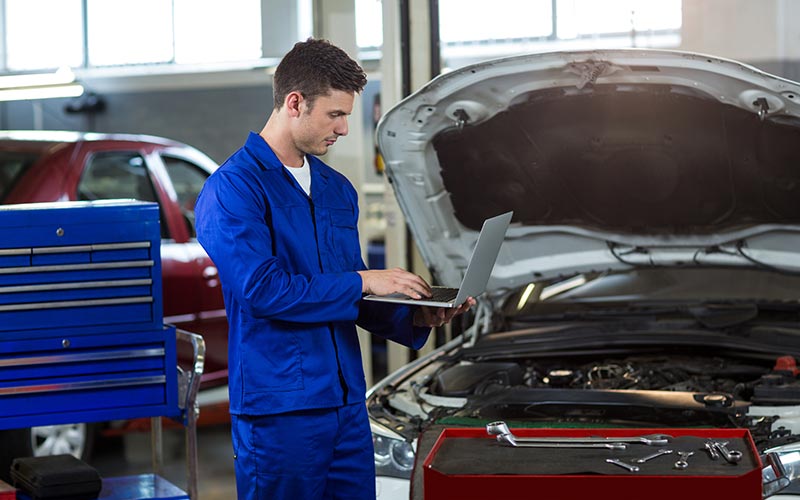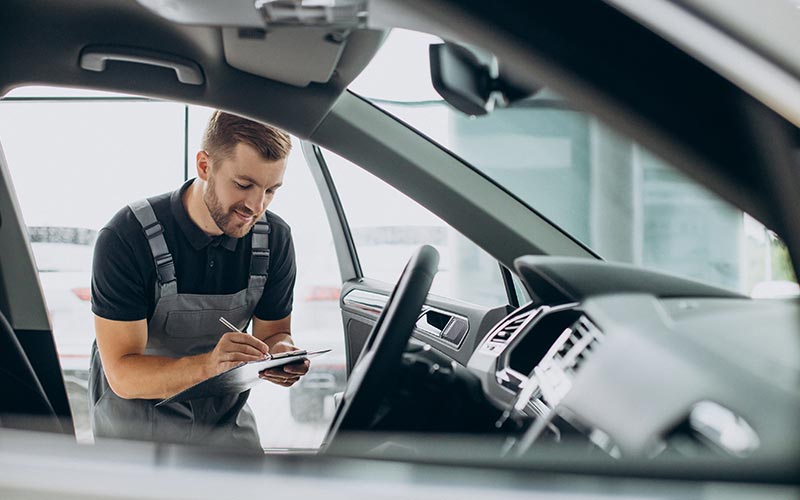How to Inspect a Used Car?
Posted Thursday, Apr 25, 2024
Finding a reliable used car can be an attractive option. However, unlike purchasing a new vehicle with a manufacturer's warranty, inspecting a used car before you buy is critical. A thorough inspection can help you avoid unexpected repairs and ensure you get a car that meets your needs and budget.

This blog will walk you through a step-by-step process for inspecting a used car, focusing on key areas like the exterior, interior, engine, and performance during a test drive. We'll also provide tips on what to look for and potential red flags to be aware of. By following these steps, you'll be well on your way to finding the perfect used car for you.
How To Inspect A Car Before Buying?
Inspecting a used car requires a systematic approach to ensure you don't miss any crucial details. Here's a breakdown of the key areas to examine:
Start with a Visual Inspection: Begin by thoroughly examining the car's exterior for any dents, scratches, rust spots, or uneven paintwork. Look for misaligned panels or gaps that could indicate previous collision damage. Next, move on to the interior. Check for rips, stains, or significant wear and tear on the seats, upholstery, and carpets. Inspect the functionality of all interior features like power windows, locks, air conditioning, and entertainment system.
Pop the Hood and Check the Engine: Open the hood and look for any leaks or signs of fresh repairs. Check the engine oil dipstick for its color and consistency - dark or creamy oil suggests potential issues. Ensure all hoses and belts are secure and free of cracks. Look for warning lights on the dashboard that might indicate underlying problems.
Test Drive and Performance Check: The test drive is a crucial step in assessing the car's overall performance. Listen for any unusual noises from the engine or suspension. Pay attention to how the car handles turns, accelerates, and brakes. Test all the safety features like anti-lock brakes (ABS) and airbags (if equipped) following the manufacturer's guidelines in a safe environment.
Don't Forget the Paperwork: A used history paints a valuable picture of its condition. Request the vehicle history report which details past accidents, repairs, and ownership changes. Ensure the car's title is clean and free of liens. Finally, verify that the car's odometer reading matches the service records.
Importance Of Vehicle Inspection
A vehicle inspection before buying a used car is much more than just a cursory glance. It's a critical step that safeguards your safety, finances, and overall satisfaction with your purchase. A thorough inspection can uncover hidden problems that could lead to expensive repairs down the road. Early detection of these issues allows you to negotiate a lower price or walk away from the purchase altogether. Furthermore, a well-maintained car with a clean bill of health is more likely to be reliable and provide you with safe transportation for years to come. The process also empowers you with knowledge about the car's condition, allowing you to make informed decisions regarding future maintenance and repairs. In short, it is an investment in your safety, financial well-being, and peace of mind.
Things You Can Check Yourself (Checklist)
Inspecting a used car can be empowering, and many key aspects can be assessed without needing a mechanic. Here's a detailed checklist to guide you through a thorough examination:
Exterior Inspection:
- Body: Meticulously examine the car's entire body for dents, scratches, or any signs of prior collision damage. Look for inconsistencies in paint texture, color variations, or overspray, which could indicate repairs. Uneven panel gaps or misaligned doors and trunks can also signal past bodywork.
- Paint: Check the paint for fading, blistering, or peeling. Rust spots, especially around the fenders, wheel wells, or underneath the car, are a major concern. Look for areas where touch-up paint might be hiding rust.
- Glass: Inspect the windshield, windows, and mirrors for cracks, chips, or scratches that could obstruct your vision or compromise their integrity.
- Lights: Turn on all headlights, taillights, brake lights, turn signals, and hazard lights. Ensure all bulbs are functioning properly and the light housings are free of cracks or moisture.
- Tires: Check the tire tread depth using a penny test (insert a penny between the tread grooves - if part of Lincoln's head is visible, the tires need replacing). Look for uneven tire wear, which can indicate alignment problems. Ensure all tires are properly inflated to the manufacturer's recommended pressure (check the sticker inside the driver's door jamb). Examine the sidewalls for any bulges or cracks, which could be signs of potential tire failure.

Interior Inspection:
- Seats and Upholstery: Inspect the seats, carpets, and door panels for rips, stains, or excessive wear and tear. Test the functionality of all seat adjustments and ensure the upholstery feels firm and supportive.
- Dashboard: Look for any cracks, warping, or missing components on the dashboard. Check all warning lights on the instrument cluster and ensure none are illuminated.
- Electronics: Turn on the radio, air conditioning, heater, and all other electronic features. Ensure they function properly and no unusual noises are present. Test the power windows, locks, sunroof (if equipped), and adjustability of mirrors.
- Safety Features: Check that all seat belts buckle and retract smoothly. If airbags are equipped, ensure there are no visible signs of deployment or tampering. Test the functionality of the parking brake.
Under the Hood Inspection:
- Engine Compartment: Open the hood and look for any leaks or signs of fresh repairs. Ensure all hoses and belts are secure, free of cracks, and properly routed. Check the engine oil dipstick for its color and consistency - dark or creamy oil suggests potential issues. Look for the battery and ensure the terminals are clean and free of corrosion. Look at the engine coolant reservoir and ensure the coolant level is appropriate.
Mechanical Inspection (During Test Drive):
- Engine Start-Up: Pay attention to how easily the engine starts and listen for any unusual noises during startup.
- Performance: Once on the road, listen for any clunking, grinding, or knocking sounds from the engine or suspension. Test the car's acceleration and braking to ensure smoothness and responsiveness. Pay attention to how the car handles turns and maneuvers. If possible, test the car on different road surfaces to assess its handling over bumps or uneven terrain.
- Transmission: Focus on how smoothly the car shifts gears, both automatically or manually. Avoid any jerking or hesitation during gear changes.
Even though this checklist allows you to conduct a comprehensive inspection, consulting a trusted mechanic for a professional evaluation is highly recommended, especially for those unfamiliar with car mechanics.
Conclusion
Inspecting a used car before buying it may seem daunting, but with the knowledge and resources provided in this guide, you're well on your way to making an informed decision. Remember, a thorough inspection empowers you to avoid unexpected repairs, ensures you get a car that meets your needs, and provides peace of mind on the road. By following the steps outlined above, remaining vigilant during your inspection, and consulting a trusted mechanic when needed, you'll be well-equipped to find the perfect used car for you. At Honest Autos, we're committed to providing our customers with reliable and well-maintained vehicles. Visit our website or contact us today to view our inventory and find your dream car with confidence.
FAQ’s
- What are some red flags to look for during a car inspection?
Be wary of any car with extensive bodywork, paint inconsistencies, or signs of rust. Uneven tire wear, leaks under the hood, or a dirty engine compartment can also signify potential problems. During the test drive, listen for any unusual noises from the engine, clunking sounds in the suspension, or hesitation during gear changes. A car that's difficult to start or exhibits sluggish acceleration might require repairs. Always be cautious of sellers who are unwilling to provide service records or a vehicle history report.
- Should I get the car inspected by a mechanic before buying it?
While a self-inspection can be valuable, a pre-purchase inspection by a qualified mechanic is highly recommended. Mechanics possess the expertise and tools to diagnose hidden issues and assess the car's overall mechanical health. They can identify potential problems with the engine, transmission, brakes, suspension, and other critical systems that might escape your notice. The cost of a pre-purchase inspection is a wise investment that can save you from significant repair costs down the road.
- What paperwork should I request from the seller?
Always ask the seller for the car's vehicle history report. This report details the car's past accidents, repairs, and ownership changes. A clean vehicle history report provides peace of mind and allows you to verify the car's mileage against the service records. Ensure the car's title is clean and free of liens, meaning there are no outstanding debts on the vehicle.
- What tools will I need to conduct my own car inspection?
A flashlight is essential for illuminating darker areas under the hood and inside the car. You can also bring a rag to wipe down the engine compartment and inspect for leaks. A penny can be used for a simple tread depth check on the tires (insert the penny head-first between the tread grooves - if part of Lincoln's head is visible, the tires need replacing).
- What if I'm not comfortable inspecting the car myself?
If you're unfamiliar with car mechanics or feel apprehensive about inspecting the car alone, consider taking a friend or family member who has some car knowledge with you. Alternatively, you can enlist the help of a professional inspector who specializes in used car evaluations. Their expertise can provide valuable insights and ensure you don't miss any critical details.
